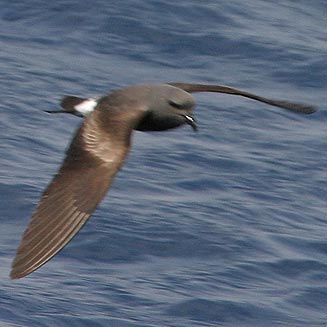|
Oceanodroma leucorhoa (Leach's
storm-petrel)
Swaelstertstormswael [Afrikaans]; Vaalstormvogeltje
[Dutch]; Océanite cul-blanc [French]; Wellenläufer [German];
Painho-de-cauda-forcada [Portuguese]
Life
> Eukaryotes >
Opisthokonta
> Metazoa (animals) >
Bilateria >
Deuterostomia > Chordata >
Craniata > Vertebrata (vertebrates) > Gnathostomata (jawed
vertebrates) > Teleostomi (teleost fish) > Osteichthyes (bony fish) > Class:
Sarcopterygii (lobe-finned
fish) > Stegocephalia (terrestrial
vertebrates) > Tetrapoda
(four-legged vertebrates) > Reptiliomorpha > Amniota >
Reptilia (reptiles) >
Romeriida > Diapsida > Archosauromorpha > Archosauria >
Dinosauria
(dinosaurs) > Saurischia > Theropoda (bipedal predatory dinosaurs) >
Coelurosauria > Maniraptora > Aves
(birds) > Order: Ciconiiformes
> Family: Hydrobatidae
 |
|
|
Leach's storm-petrel, offshore of California, USA.
[photo Martin Meyers
©] |
|
Distribution and habitat
It is a common summer visitor to southern
African waters off the western and southern coast. Breeds on islands in the North Pacific and North and South
Atlantic Oceans, with northern breeders heading south to the tropics and
subtropics in the non-breeding season. It has bred in very small numbers on Dassen and Dyer islands in the Western Cape. A single bird occupied a burrow on St Croix Island (Eastern Cape) for a number of years but no evidence of breeding was discovered (Philip Whittington, pers. comm.).
Movements and migrations
It is both a breeding and non-breeding migrant
to southern Africa, arriving around September-November and departing
in the period from February-April.
Food
It mainly eats small fish, squid, planktonic crustaceans,
copepods and offal, foraging both in the day and at night. Most prey are caught
by dipping its head into the water and extracting the animal, sometimes
following marine mammals to feed on food scraps or faeces.
Breeding
- Little known in southern Africa, as the total South African breeding
population is thought to be about 25 pairs.
- The nest is excavated by the female, consisting of a burrow ending in a
nest chamber which is lined with small pieces of woody vegetation and
sometimes grass. It may also use a rock crevice or burrow dug by another
species.
- Egg-laying season probably peaks in November.
- It lays a single egg, which is incubated by both sexes for about 38-42
days, sometimes up to 50 days if the nest was for some reason left
unattended for several days.
- The chick is brooded for the first 4-6 days its life and by 55 days or
so it is already roughly twice the adults mass. By the time it fledges at
61-70 days old its weight has decreased to only slightly more than that of
its parents, at which point it becomes independent.
Threats
Not globally threatened, but Endangered in South
Africa, where its population is small and threatened by predation of Domestic
cats (Felis catus) and Kelp
gulls at its colonies.
References
-
Hockey PAR, Dean WRJ and Ryan PG 2005. Roberts
- Birds of southern Africa, VIIth ed. The Trustees of the John Voelcker
Bird Book Fund, Cape Town.
|
